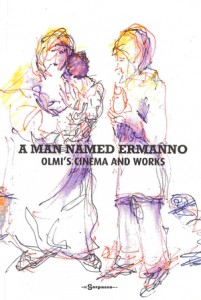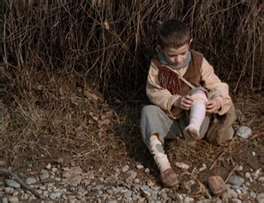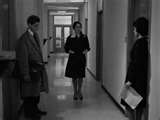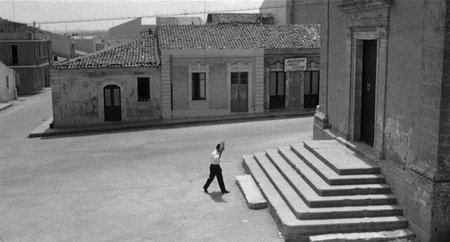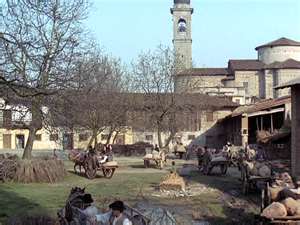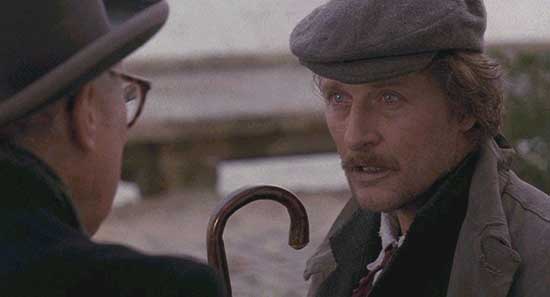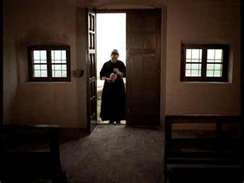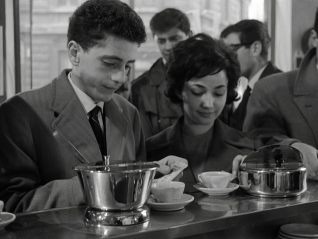Written for A Man Called Ermanno: Olmi’s Cinema and Works, published by Edições Il Sorpasso (in Lisbon) in May 2012. A French translation of this essay has been published in Trafic #91, automne 2014. — J.R.
For me, the cinema is a state of mind and a process of analysis from a series of detailed observations.
— Ermanno Olmi, from a 1988 interview (1)
1
Ermanno Olmi first became well known as a filmmaker during the period in the early 1960s when the Nouvelle Vague and, more specifically, François Truffaut’s formulation of la politique des auteurs, were near the height of their international influence. Yet it seems that one factor that has limited Olmi’s reputation as an auteur over the half-century that has passed since then is his apparent reluctance and/or inability to remain type-cast in either his choice of film projects or in his execution of them. Indeed, the fact that he repeatedly eludes and/or confounds whatever auteurist profile that criticism elects to construct for him in its effort to classify his artistry results in a periodic neglect of him followed by periodic “rediscoveries”. And these rediscoveries are confused in turn by the fact that each rediscovery of Olmi’s work seems to redefine his profile rather than build on the preceding one.
At least this has been the gist of my own experience. Although I’m clearly restricted by having seen only four Olmi features to date, the spotty and limited international distribution that his work has received has largely been responsible for this impasse. And the incomplete grasp that I have of Olmi as an auteur is not only a consequence of this problem but, more symptomatically, part of the problem itself insofar as it has inhibited me from making further explorations. In other words, he has largely fallen outside most international canons precisely because his work has resisted easy classification.
Olmi’s style is frequently described as simple, but once any attempt is made to elaborate on this observation, this alleged simplicity often turns out to be far from simple — perhaps because Olmi’s responses to his material usually turn out to be less pure than we initially assume them to be, and more intuitively open to chance, circumstance, and/or expressive variations than criticism often cares to admit. Consider, for instance, the brief sequence in Il posto (1961) that follows Domenico (Sandro Panseri) on his way home from Milan following a day devoted to his job application, during which he meets Magali (Loredana Detto), another applicant for a job at the same company.If we compare this sequence to Domenico’s walk to the train station from his home the previous morning, the differences are quite striking.
We see him leave his family’s third-story apartment with his brother Franco while their mother calls out questions to him about whether he has enough money. As we view them walking on the road in extended long shots (during which Franco gets called back to collect more money from his mother to give to Domenico), what we hear, such as the voices of Domenico and his mother and the passing traffic, appears to be recorded in direct sound. But that evening, after Domenico sees Magali depart on a bus, there’s a cut to him walking through an apparently empty train, singing to himself, as seen from outside the train and through its windows, and the fact that we can clearly hear him singing despite the camera’s position outside the train essentially proves that the sound in this sequence couldn’t be direct. Moreover, after Domenico sits down in the train, the film cuts to various shots of the train as seen from the platform that seem to reflect Domenico’s viewpoint even though the camera’s placement is anything but subjective. And meanwhile, the sound of Domenico’s singing becomes much louder and more assertive as we cut to him walking home from the train station; when we see him outside the door of his family’s apartment, the fact that this isn’t direct sound becomes confirmed by the imprecise lip sync. (We do know, however, from Olmi’s own testimony that Sandro Panseri dubbed his own character, and that he systematically got his nonprofessional actors to dub their own roles.)
We might conclude from the contrasts in both image and sound between Domenico’s walk from the train station in the morning and his walk back from the train station in the evening that the difference in approach from a relative objectivity to a relative subjectivity helps to illustrate a certain psychological observation — namely, the boost in Domenico’s confidence which comes from having completed his job application and, perhaps even more, from having met Magali, which is only intensified once he returns to his home turf and shows that he can sing more openly there without any embarrassment. But in fact, neither the objectivity in the first sequence nor the subjectivity in the second sequence qualifies as pure; both are highly selective in what Olmi wants us to see and hear. And the differences may also be a matter of technical expedience. When Olmi spoke to the late American film critic Charles Thomas Samuels in Rome in Spring 1971, he described his overall methodology and rationale as follows:
I’m not so doctrinaire as Bresson. Since the visual element is the most important thing in a film, dubbing isn’t too harmful. Furthermore, one touches up the visuals; why shouldn’t one also touch up the sound track? However, I do try to take sound directly whenever that is possible. But when I shoot in 35 mm, I can only take the sound directly when I am not using a hand-held camera, because obviously I couldn’t find a machine small enough that would also record sound. When I need to be free of trolleys and so on, I dub. (2)
The fact that Olmi most often shoots as well as edits his own films clearly gives them an artisanal quality that arguably becomes part of his films’ content. “The talkies have become the walkies,” Dwight Macdonald once wittily observed, while favorably reviewing Il posto in the August 1963 issue of Esquire, calling to mind the extent to which long walks often define as well as shape much of the Italian art cinema of this period — not only Il posto and I fidanzati (1963), but also, for instance, all of the films of Antonioni that were contemporary with them (L’avventura, La notte, L’eclisse, and Il deserto rosso). The nature of Olmi’s observations, reflected in both his shooting style and in his principles of sound-mixing (including his uses of music), tends to be psychologically as well as socially oriented.
In the interview with Olmi included on Criterion’s 2003 DVD release of Il posto, he gives an interesting rationale for his periodic inclusion of the sound of church bells during Domenico’s walks through Milan. While most viewers would take them to be both realistic and nonconsequential, his description implies that they carry a certain commentary on the action that becomes part of the film’s overall social statement, while his comparison of these bells to the sound of a mother’s voice provocatively suggests a certain psychological dimension as well: “Why did I put in the bells? They come from a more rural, agricultural world where they marked the significant times of the day — a way of communicating with the rest of the community ….[They represent] an old world that will soon be gone.”
It’s worth adding that the periodic sound of church bells in L’albero degli zoccoli (1978), which is probably Olmi’s major representation of that “old world,” while apparently more realistic and directly pertinent, appears at times to be used almost as intuitively and as expressively as it is in Il posto. Indeed, it has a similar kind of subliminal, psychological effect in creating the film’s world — Lombardy at the end of the nineteenth century — as the recurring frontal camera angle in front of the huge farmhouse where most of the action is set, which often suggests the theatrical tableau framing of some of the earliest films, which were being shot at approximately the same time, and conveys cumulatively a certain rhyme effect that links particular scenes thematically and emotionally. (The recurrence of the same camera angles in the same settings, in this case many years apart, also informs much of the dramatic construction of Mizoguchi’s 1939 masterpiece The Story of the Late Chrysanthemums, invariably leading us to recall earlier scenes and sequences while creating a certain overall sense of permanence that plays in counterpoint to seasonal and other temporal changes.)
The opening sequence of I fidanzati also uses sound at least partially in a manner that seems to be psychologically motivated. After Olmi slowly and methodically presents us with the routine, almost ritualistic opening in the evening of a dance hall that establishes the milieu and his leading characters, he presents a series of brief flashbacks in alternation within this setting that is quite unorthodox in terms of both their chronology and their succession (we even get one flashback within another flashback). All of this is clearly marked as the hero’s subjective memories that are being propelled by the music, which is kept at the same volume level in the dance hall and in the other settings of the diverse flashbacks. When Samuels interviewed Olmi, there is a meaningful and interesting exchange on this topic. Samuels: “Why are you so fond of sound bridges from one scene to another?” Olmi: “To show that the psychological state remains even though outward reality changes.” (3)
Another example of Olmi’s expressive use of sound volume comes a little later in I fidanzati. Shortly after the hero, Giovanni (Carlo Cabrini), has flown to Sicily to embark on his new job and has found temporary lodging, he wanders into a drab, nearly deserted, but brightly lit café where a radio is loudly blasting incongruously cheerful music. The sharp disconnect here between sound and image perfectly captures the alienation and displacement being experienced by Giovanni.
Perhaps one could find no better illustration of Olmi’s capacity to lend psychological and social significance to his sounds than the loud and relentless sound of a copying machine that accompanies both the final shots and then the closing credits of Il posto, which is again held at the same volume level. As in the earlier sequence that cuts away from Domenico at work to see depressing glimpses of his older colleagues at home, the present is metaphorically expanded to represent both the future and the shape of entire lives, thus making each character, in effect, a“copy” of the others that has been pressed out by the drudgery and monotony of work.
2
We tend to associate the Nouvelle Vague with both youth and various stylistic departures such as those that I’ve just been describing. In fact, the term itself was originally coined by the weekly magazine L’Express, in its October 3, 1957 issue, in reference to youth rather than to film per se, and it’s worth recalling that Olmi’s worldwide reputation only came with his second feature, Il posto, when he was already pushing thirty. (Regrettably, I haven’t seen his first feature, Il tempo si è fermato [1959], so I can’t discuss it here in any detail.) And his status as a stylistic innovator, which relates chiefly to his early features, seems determined and inflected most of all by his concern with content rather than any apparent desire to shake up film aesthetics; it was apparently arrived at more by default than by design. This content, moreover, might be described as a particular kind of speculative autobiography — that is, stories and situations based to some extent (and by his own testimony) on Olmi’s own experiences, which are seemingly combined with some speculation about how his life might have developed if he hadn’t become a filmmaker. Similarly, L’albero degli zoccoli might be described as a speculative account of his grandparents’ life around the turn of the century. In the case of The Legend of the Holy Drinker (1988), the only other Olmi feature that I’ve seen, it could describe this literary adaptation as a form of speculative spiritual autobiography — precipitated in this case by his contraction of a rare and crippling neurological disease that interrupted Olmi’s career between 1984 and 1987, and, by his own account, obliged him to anticipate and contemplate the prospect of his own death.
“I discovered my first subjects in myself,” Olmi said Samuels. “For example, the boy in [Il posto] is me; the worker who goes to Sicily in [I fidanzati] is also me. The young boy in my first film, [Il tempo si è fermato], is certainly me. Each film, except, obviously, [E venne un uomo], was about me — until [Un certo giorno].” (4) This autobiographical content covers the period when Olmi was working as a clerk for the Edison-Volta electric plant in Milan — a period during which Olmi first became involved with filmmaking, by shooting various industrial documentaries for the company, one of which surreptitiously grew into Il tempo si è fermato — although presumably the filmmaking itself is a subject that Olmi’s early features fail to deal with.
3
Critical typecasting inevitably stems from a desire for simplification, but more often than not this is a sort of practice that can lead to various distortions. Several years ago, when I was still working as a regular film reviewer for the Chicago Reader, I received an e-mail one day from a reader wishing to know how I could have possibly described The Tree of Wooden Clogs as Marxist when it was so clearly a religious film. In fact, it had been Dave Kehr, my predecessor, who had written the Chicago Reader’s capsule review of Ermanno Olmi’s feature back in 1985, two years before I’d started work on that newspaper, and the way he had employed the term “Marxist” is not something I would have agreed with myself: “The characters and situations are oppressively familiar; Olmi’s wide-eyed, wondering point of view helps to freshen them, but not enough to overcome completely the Marxist sentimentalism inherent in the concept.”
Nevertheless, under these circumstances, going into my disagreement with Kehr might have only led to more confusion, so adopting the usual reflexes of a journalist wishing to simplify issues rather than complicate them, I hastily e-mailed my correspondent that any Italian would tell you that Marxism could easily be seen as a form of religion. Afterwards, I realized that this response was unnecessarily flippant and in its own way misleading — a prime instance of one form of simplification being used to “correct” another one. On further reflection, I concluded that it would have been better to say that Catholicism and Marxism have had a long and complex coexistence in Italy, and it was unrealistic to expect that they would be mutually exclusive as systems of belief; the complex and multifaceted career of Pier Paolo Pasolini stands as proof of how intimately the two can be intertwined, regardless of — or perhaps even because of — the various contradictions involved. This led me to think about how the similar characterizations of European Marxism in the United States tend to foster such confusion; indeed, it is even possible to argue that the term “Marxism” doesn’t even mean the same thing in the U.S. and Europe. Shortly after this, I happened to read André Bazin’s description of The Bicycle Thief as one of the great Communist films — an aspect of the film that I strongly suspect couldn’t have been apparent to American audiences when it won the Academy Award for best foreign film in 1949. And still more recently, after reseeing The Tree of Wooden Clogs and Olmi’s much earlier Il posto and I fidanzati, I realized that calling Olmi a Marxist in the same sense that Pasolini was one was already an over-simplification that can perhaps only be justified from a distant and American Cold War perspective (and one that unhappily persists today), according to which almost any leftist-humanist European position can be — and often is — perceived as Marxist.
4
Typically, film directors become familiar to the public through various forms of critical packaging, and the difficulty in situating Olmi comfortably within the traditions of either Italian Neorealism or the Nouvelle Vague have led to a blurry and uncertain critical profile that has only become more confused over time. His film career began in the shadow of what might be described as post-Italian-Neorealism — especially in his reliance on shooting in natural locations, but also in going further in Neorealism’s move away from the conventions of studio filmmaking by adopting the same procedure employed in Banditi a Orgosolo and Accatone (the first features of Vittorio De Seta and Pier Paolo Pasolini, both released in 1961, the same year as Il posto), to use only nonprofessional actors. And the use of both natural locations and nonprofessional actors in his subsequent and comparably well-known I fidanzati(1963) and L’albero degli zoccoli (1978) would appear to confirm that these characteristics were essential parts of his auteurist profile, to which one should add the aforementioned autobiographical elements.
Furthermore, the location shooting and some of the editing procedures of Il posto and I fidanzati, in addition to some of the autobiographical, psychological, and sociological elements and the uses of direct sound, parallel those associated with some of the French filmmakers of the Nouvelle Vague — in particular, Truffaut and Jean-Luc Godard regarding the autobiographical elements, Godard regarding the sociological elements, Resnais regarding the psychological elements, and Godard and Rivette in the employments of direct sound. (Unless one counts Vivre sa vie in 1962, Godard’s uses of direct sound and his sociological interests as exemplified in La femme mariée and Masculin féminine suggests that I fidanzati might conceivably have influenced Godard, but it appears less likely that Godard influenced Olmi.)
Yet how, then, can one account for Olmi’s 1988 The Legend of the Holy Drinker — one of his most famous and celebrated subsequent films, and apparently another personal project, winner of the Golden Lion at the Venice Film Festival? This latter film not only employs many professional actors and is largely studio-shot; it’s also a close literary adaptation of a novel in German whose spoken dialogue is chiefly in English and secondarily in French, and it appears to have no direct autobiographical elements in relation to Olmi (although it does seem to have a few in relation to Joseph Roth, who wrote the story of the same title serving as the literary source). And even though the frequent use of sets appears to preclude the sort of direct sound employed in Il posto, I fidanzati, and L’albero degli zoccoli, one can none the less observe aspects of Olmi’s expressive sound mixing, such as the way certain sounds precede their corresponding images (e.g,, those of the Seine, which come before the film’s opening shot), that seem consistent with those in the earlier features.(Equally consistent, alas, is the relatively conventional selection of musical pieces chosen as accompaniments, such as the Bach used in L’albero degli zoccoli and the Stravinsky used in The Legend of the Holy Drinker — not to mention the pop music used in Il posto and I fidanzati.)
Olmi, who has usually avoided literary adaptations, agreed to make this movie of the Roth story only after his friend and frequent writing collaborator Tullio Kezich (1928-2009) presented him with a copy of this story at a dinner party. According to Michael Hofmann, the English translator of the story, it was written “quite deliberately” as well as slowly, as Joseph Roth’s final work of fiction while he was in the process of drinking himself to death in Paris at age 44 (5). Like Ulrike Ottinger’s Bildnis Einer Trinkerin (aka Aller Jamais Retour/ Ticket of No Return, 1979), which deals with a similar theme, Roth’s story is paradoxically a work of ironic celebration more than one of complaint or defeat, although the irony is far less apparent in the fate of Andreas Kartak (Rutger Hauer) in Olmi’s version. As the British film critic Tom Milne pointed out in his review of the film, it is a very close and superficially very faithful adaptation, ending with the same epitaph on the death of Andreas — “May God grant us all, all of us drinkers, such a good and easy death” — yet “the explicit irony of Roth’s personal voice, interjecting as narrator to cast cold water over [the] Biblical resonances, has been suppressed.” (6) And indeed, as Olmi admitted to Don Ranvaud in an interview (see footnote 1), he deliberately avoided reading anything else by Roth or anything about his life before making the film: “He [Roth] became a perfect and discreet accomplice, perhaps not dissimilar from the stranger/benefactor in the story.”
One could hypothesize that, apart from Olmi’s near-brush with death, the element in Roth’s strange story that struck a personal chord with Olmi may well have been the almost obsessive recurrence of the word “miracle”. For it would appear that the notion of miracles as responses to prayers has a very special meaning for this filmmaker, which can be seen not only in the seemingly miraculous recovery of the sick cow in L’albero degli zoccoli, but also in Olmi’s own remarkable account of the arrival of the rainstorm in the final scene of I fidanzati:
You must remember that in Sicily it never rains during August and September. You shouldn’t tell anyone this story, because he will laugh at me! It exemplifies the mentality of a Catholic and a peasant. Here I was, needing a storm when there couldn’t be any, so I started up an internal dialogue with my grandmother, who was no longer alive then. I kept praying for her to help me, and I went slowly on the retakes in the hope that she would. One day that oppressive Sicilian heat was so dreadful that no one could sleep, so we worked through the night. When I finally got to sleep, I had this crazy dream: I was shooting my last scene in a downpour so terrific that it was actually painful; even the trees were bending under it. I went on filming, while my grandmother looked on, happy and satisfied. Imagine how I felt when I awoke from that vivid dream to see an utterly clear sky. Nevertheless, I told everyone to get ready for work because it would rain that day. They looked at me as if I were crazy….But by afternoon a storm came. Suddenly I found myself exactly as I had been in the dream, shooting in a downpour, with trees swaying all around me. […] (7)
5
Clearly we have to revise some of our presuppositions about what defines Olmi from an auteurist perspective if we wish to consider The Legend of the Holy Drinker as a meaningful part of his oeuvre. But in the process of this revision, we may also need to reconsider, once again, what we mean by both Italian Neorealism and the Nouvelle Vague. For insofar as both these movements were very much collective phenomena — the result of friends having coffee and conversing and working together over protracted periods — Olmi needs to be considered separately insofar as he remains a relatively independent loner, creating and following his own laws. (One should note, however, that at least two of his children have also entered the world of cinema — Fabio as a cinematographer and Elisabetta as a producer). In this respect, he may be more comparable to notable outsiders in the French cinema, such as Bresson and Jacques Tati, than he is to filmmakers associated with either post-Italian-Neorealism or the Nouvelle Vague.
Like Bresson, he projects a spiritual sense of gravity over his plots, especially when he expands his expressive palette to suggest cosmic dimensions, yet like Tati he is also a master of “small” social observations (Domenico and Magali each examining the bottoms of their coffee cups in an attempt to behave “typically” in a Milan café is a classic Tatiesque moment.)
Logically speaking, one can’t postulate a tradition of eccentricity in any field of endeavor without perpetrating an oxymoron. But in attempting to describe as well as account for the eccentric styles, methods, and techniques of Il posto and I fidanzati, we can at least speak about a few tendencies that can be found in several other idiosyncratic “outsider” artists apart from Bresson and Tati.
One of these tendencies would be the reinvention of many of the basic practices and poetic principles of their specific art forms that is found in artists with rustic and/or small-town backgrounds, such as French painter Henri Rousseau (1844-1910), Ukrainian filmmaker Alexander Dovzhenko (1894-1956), American novelist William Faulkner (1897-1962), American filmmaker Jonas Mekas (born 1922), American filmmaker David Lynch (born 1946), and Chinese filmmaker Jia Zhangke (born 1970), among others — some of whom, like Olmi, might be said to invent their own forms of syntax.
Another tendency, much less common, would be for the artist to remain in his or her home town or at least outside the main centers of culture and communication (i.e., in Faulkner’s case, outside of New York; in Olmi’s case, outside of Rome), which typically results in both a delay in public recognition and remaining relatively unfashionable. In Olmi’s case, it’s worth pointing out that after Il posto opened in Paris somewhat belatedly, it tied with Nico Papatakis’ Les Abysees for 25th place in Cahiers du Cinéma’s list of the best films of 1963, and I fidanzati did only slightly better the following year, winding up in 17th place — just behind Raoul Walsh’s A Distant Trumpet and just ahead of Mark Donskoi’s Thomas Gordeyev. (Uncharacteristically, however, and quite surprisingly, I fidanzati also occupied first place in Jean-Luc Godard’s personal list of favorite films for that same year, 1964 — just ahead of Gertrud, Marnie, Man’s Favorite Sport, and Il deserto rosso, in descending order—which is partially why I have hypothesized the possibility of this film exerting an influence on Godard.)
One final tendency to note that’s relevant to Olmi would be the relatively late start of some artists in discovering and/or practicing their particular art forms; restricting ourselves now only to filmmakers, we might think of D.W. Griffith, 1875-1948, who began making films in 1907; Robert Bresson, 1901-1999, who made his first short film in 1934 and his first feature in 1943; Jacques Tati, 1907-1982, who made his first feature in 1947; Nicholas Ray, 1911-1979, who made his first feature in 1947, and Samuel Fuller, 1912-1997, who made his first feature in 1949. Olmi, to be sure, made his first documentary shorts in his early 20s, but it also seems relevant that he only turned to fiction and feature filmmaking in his late 20s. As with Griffith, Bresson, Tati, Ray, and Fuller — a very prestigious and varied honor roll — it would be fair to say that Olmi’s early features clearly reflect, and to their own advantage, the life experience of someone who has lived for many years outside the world of cinema. This remains an essential part of their mystery and their uncommon power.
End Notes
- “A Discreet Accomplice: Ermanno Olmi” by Don Ranvaud, Monthly Film Bulletin, Vol. 55, No. 657, October 1988, 316 (back cover).
- Samuels, Charles Thomas, Encountering Directors, New York: Da Capo, 1987 (second edition), 101.
- Ibid., 112.
- Ibid., 100.
- Translator’s Note, Right and Left/The Legend of the Holy Drinker,Woodstock, NY: The Overlook Press, 1992, 289-291.
- Monthly Film Bulletin, Vol. 56, No. 668, September 1989, 277-278.
- Samuels, Charles Thomas, op. cit., 109-110.

